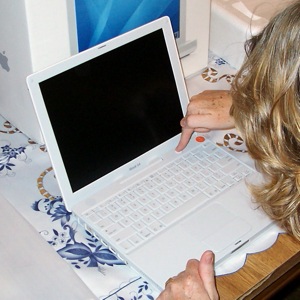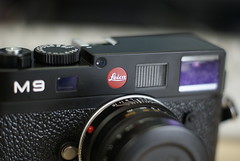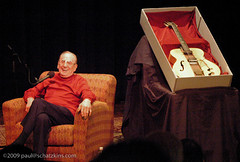Penmachine
30 September 2009
Blasphemy: funny if it weren't often so dangerous
 Today is International Blasphemy Day (of course there are a Facebook page and group). The event is held on the anniversary of the 2005 publication in Denmark of those infamous cartoons of the Prophet Muhammad. Subversive cartoonist Robert Crumb is coincidentally in on the action this year too, with his illustrated version of the Book of Genesis.
Today is International Blasphemy Day (of course there are a Facebook page and group). The event is held on the anniversary of the 2005 publication in Denmark of those infamous cartoons of the Prophet Muhammad. Subversive cartoonist Robert Crumb is coincidentally in on the action this year too, with his illustrated version of the Book of Genesis.
Blasphemy Day isn't aimed merely at Islam or Christianity, but at all and any religions and sects that include the concepts of blasphemy, apostasy, desecration, sacrilege, and the like. "Ideas don't need rights," goes the tagline, "people do."
While my grandfather was a church musician, and my parents had me baptized and took me to services for a short while as a youngster, I've never been religious, so no doubt I blaspheme regularly without even thinking about it. I've written plenty about religion on this blog in the past few years, often blasphemously in someone's opinion, I'm sure. In 2007 I wrote my preferred summary of my attitude:
The beauty of a globular cluster or a diatom, the jagged height of a mountain or the depth of geological time—to me, these are natural miracles, not supernatural ones.
In that same post, I also wrote tangentially about blasphemy:
...given the scope of this universe, and any others that might exist, why would any god or gods be so insecure as to require regulated tributes from us in order to be satisifed with their accomplishments?
If the consequences—imposed by humans against each other, by the way—weren't so serious in so many places, the idea of blasphemy would be very funny. Even if there were a creator (or creators) of the Universe, how could anything so insignificant as a person, or even the whole population of a miniscule planet, possibly insult it?
We're talking about the frickin' Universe here. (Sorry, should be properly blasphemous: the goddamned Universe.) You know, 13.7 billion years old? Billions of galaxies, with billions of stars each? That one? Anything happening here on Earth is, on that scale, entirely irrelevant.
To my mind, there are no deities anyway. But if you believe there are, please consider this: it's silly to think that a god or gods could be emotionally fragile enough to be affected by our thoughts and behaviours, and even sillier to believe that people could or should have any role in enforcing godly rules. Silliest yet is that believers in a particular set of godly rules should enforce those rules on people who don't share the same belief.
Being a good person is worth doing for its own sake, and for the sake of our fellow creatures. Sometimes being good, or even simply being accurate, may require being blasphemous by someone else's standards. Today is a day to remember that.
Labels: controversy, linkbait, politics, religion, science
28 September 2009
SOLD: 2005 12-inch iBook G4, $450 Cdn
UPDATE: As of the beginning of October, the iBook is sold, sorry! Thanks to those who were interested.
 Back in 2005 my wife Air bought her first laptop, the excellent workhorse 12-inch iBook G4 (the photo shows her starting it up for the first time back then). She replaced it with a MacBook earlier this year, and we're not using the iBook as much as we thought, so it's time to sell it to someone who'll take good care of it.
Back in 2005 my wife Air bought her first laptop, the excellent workhorse 12-inch iBook G4 (the photo shows her starting it up for the first time back then). She replaced it with a MacBook earlier this year, and we're not using the iBook as much as we thought, so it's time to sell it to someone who'll take good care of it.
We're asking $450 Canadian. Our friends and blog readers get first dibs, and if you're in Greater Vancouver, we'll deliver it or arrange to meet you. If you want a small-size 12" Mac notebook, this is one of the last ones Apple made (with a matte screen, even). Air has been the only owner, and she's treated the iBook very well.
The details: it has a 12" screen (1024x768 resolution), 1.2 GHz PowerPC G4 processor, 768 MB RAM, 30 GB hard drive, Combo Drive (CD, DVD, CD-R, CD-RW), AirPort Extreme (Wi-Fi 802.11g) wireless built in, and ATI Radeon 9200 graphics. Mac OS X 10.5 Leopard, iLife '09, iWork '09 are installed. You get the original iBook install and restore disks, box, packaging, cables, etc., and a new battery.
I just completely restored the software install, so the machine boots up with the Setup Assistant like it's fresh from the factory for you to configure as you like, including all the swoopy Apple multilingual "welcome" space graphics and groovy "do do dee-do do" startup soundtrack. The case, screen, and keyboard are all freshly cleaned. It's white like a kid's teeth before they're old enough to drink Coke, coffee, or red wine.
Email me or contact me via Twitter or Facebook if you'd like to make a good home for this little cutie.
P.S. I think we have a couple of mini-VGA to VGA and mini-VGA to composite video adapters we can throw in too, so you can hook the iBook up to a projector, external monitor, or TV.
Labels: forsale, geekery, macosx, vancouver
27 September 2009
The scramble
I played the gig last night at the tony private Shaughnessy Golf and Country Club, covering percussion, some drumming, background vocals, and (the first time for a performance that long) rhythm guitar. I was a bit of mess—my health was fine, but the three instrumental roles, plus singing, include lots of mental and physical gymnastics, so I usually felt like I was scrambling along a bit behind the others. I did okay, and I had a lot of fun.
It was also the first time this particular band lineup had worked together. We have another show next Saturday, and I expect I'll do a bit better, particularly since I'll improve my sense of what I should play on different songs. I also think a week is about the right amount of recovery time. Thanks to Jeremy, Dave, Rose, Sebastien, and Christian for having me sit in for these two Saturdays. It's been a nice break during my ongoing cancer-treatment nastiness.
Labels: band, cancer, friends, music, vancouver
26 September 2009
Links of interest (2009-09-26):
- Photo sharing site Flickr has these new Gallery things.
- Homemade stratosphere camera rig goes sub-orbital to 93,000 feet (18 miles). Total cost? $150.
- Suw Charman's life is "infested with yetis."
- AIS is the way that commercial ships and boats report their near-coastal positions for navigation. The Live Ships Map uses AIS data to show almost-real-time positions for vessels all around the world. Zoom in and be amazed.
- Strong Bad Email #204 had be laughing uncontrollably. Make sure to click around on the end screen for the easter eggs.
- Julia Child boils up some primordial soup. Really.
- Funky bracelets made from old camera lens housings. Nerdy, yet cool.
- Adobe Photoshop Elements 8: most of the cool features, about 85% cheaper than regular Photoshop.
- Vancouver's awesome and inexpensive Argo Cafe finally gets coverage in the New York Times.
- When people ask me to spell a word out loud, I notice that I scrunch up my face while I visualize the letters behind my eyelids.
- Via Jeff Jarvis: in the future, if politicians have nothing embarrassing on the Net, we'll all wonder what it is they're hiding and why they've spent so much effort expunging it.
Labels: cartoon, evolution, flickr, food, linksofinterest, marine, photography, politics, restaurant, science, software, vancouver, web
23 September 2009
A question about pets
Dave has a stroller for his little dog. Ianiv and Arieanna have had to put their cat on antidepressants. How is it that pets are easier than children again?
22 September 2009
The big cry
I've been digitizing some of our old home videos (using a DVD recorder and a Video8 camera borrowed from Paul to replace our long-broken one). Footage of my daughters as babies prompted me to hunt for a particular old scan—this one:
I think I took the two pictures in 2002, when my daughter was about two and a half. She's nine years old now. And I doubt she'd let me get away with taking a similar photo today.
Labels: family, memories, photography, video
21 September 2009
Jack of all trades
 I studied classical guitar as a kid, between 1978 and 1982, but I was never especially good at it. I quit when I changed schools and forgot pretty much everything about it, including my rudimentary ability to read music.
I studied classical guitar as a kid, between 1978 and 1982, but I was never especially good at it. I quit when I changed schools and forgot pretty much everything about it, including my rudimentary ability to read music.
A few years later I discovered a talent for the drums, and with my then-roommate Sebastien learned to play classic sixties garage rock. By the end of the 1980s we'd formed a band and played our first gig. Twenty years later, he and I are still in The Neurotics together, playing many of those same songs.
I don't play as often as I used to, because my cancer and the associated medication side effects make me weak and unreliable, but the group is kind enough to let me sit in when I can, alternating with Christian on drums and percussion on nights I can make it out. This upcoming weekend, I plan to play yet another show, but in addition to drums, percussion, and vocals, I'll be trying my hand at electric guitar for a good chunk of the set—the first time I've done that live onstage in any serious way for many years.
Of course I resumed playing guitar a long time ago, not long after we started that first garage band in 1989, and I've even recorded a whole album of guitar-based instrumentals, derived from my irregular podcast. But that was by myself, in the basement, where I could fix my mistakes. Live, in front of an audience, I don't get that chance.
So I'm spending some time re-learning all those songs I've known for decades, but this time I have to know what key they're in and what the chords are. My fingers are a little sore from the practice, but one other advantage is that I'll know a bunch of tunes I can teach my youngest daughter, who says she's ready to start playing the guitar I bought her a few years ago. She's nine, the same age I was in 1978.
Labels: band, fear, guitar, memories, music
18 September 2009
Summer clouds
By mid-September, Vancouver weather has usually shifted to the grey and dreary stereotype we live with much of the year. While we've had a bit of that, this month has exhibited an unusual share of full-on hot summer sunshine, with more looking to come next week. Yesterday, with the kids at school and my wife at work, I found a pleasant spot in a park atop Capitol Hill in Burnaby and watched the clouds go by:
The movie is yet another time-lapse video I assembled using my Nikon D90 and Apple's iMovie software. I was in Harbour View Park, but the foliage is thick enough right now that you can't really see the harbour. It is visible from a couple of nearby streets, however.
Labels: park, sunshine, vancouver, weather
14 September 2009
Book Review: Say Everything
 It's a bit weird reading Say Everything, Scott Rosenberg's book about the history of blogging. I've read lots of tech books, but this one involves many people I know, directly or indirectly, and an industry I've been part of since its relatively early days. I've corresponded with many of the book's characters, linked back and forth with them, even met a few in person from time to time. And I directly experienced and participated in many of the changes Rosenberg writes about.
It's a bit weird reading Say Everything, Scott Rosenberg's book about the history of blogging. I've read lots of tech books, but this one involves many people I know, directly or indirectly, and an industry I've been part of since its relatively early days. I've corresponded with many of the book's characters, linked back and forth with them, even met a few in person from time to time. And I directly experienced and participated in many of the changes Rosenberg writes about.
The history the book tells, mostly in the first couple of hundred pages, feels right. He doesn't try to find The First Blogger, but he outlines how the threads came together to create the first blogs, and where things went after that. Then Rosenberg turns to analysis and commentary, which is also good. I never found myself thinking, Hey, that's not right! or You forgot the most important part!—and according to Rosenberg, that was the feeling about mainstream reporting that got people like Dave Winer blogging to begin with.
Rosenberg's last book came out only last year, in 2008, so much of what's in Say Everything is remarkably current. He covers why blogging is likely to survive newer phenomena like Facebook and Twitter. And he doesn't hold back in his scorn for the largely old-fashioned thinking of his former newspaper colleagues (he used to work at the San Francisco Examiner before helping found Salon).
But then I hit page 317, where he writes:
...bloggers attend to philosophical discourse as well as pop-cultural ephemera; they document private traumas as well as public controversies. They have sought faith and spurned it, chronicled awful illnesses and mourned unimaginable losses. [My emphasis - D.]
That caused a bit of a pang. After all, that's what I've been doing here for the past few years. It hit close to home. Next, page 357:
For some wide population of bloggers, there is ample reason to keep writing about a troubled marriage or a cancer diagnosis or a death in the family, regardless of how many ethical dilemmas must be traversed, or how trivial or amateurish their labours are judged. [Again, my emphasis - D.]
Okay, sure, there are lots of cancer bloggers out there. I'm just projecting my own experience onto Rosenberg's writing, right? Except, several hundred pages earlier, Rosenberg had written about an infamous blogger dustup between Jason Calacanis and Dave Winer at the Gnomedex 2007 conference in Seattle.
The same conference where, via video link, I gave a presentation, about which Rosenberg wrote on his blog:
Derek K. Miller is a longtime Canadian blogger [who'd] been slated to give a talk at Gnomedex, but he’s still recovering from an operation, so making the trip to Seattle wasn’t in the cards. Instead, he spoke to the conference from his bed via a video link, and talked about what it’s been like to tell the story of his cancer experience in public and in real time. Despite the usual video-conferencing hiccups (a few stuttering images and such), it was an electrifying talk.
Later that month, he mentioned me in an article in the U.K.'s Guardian newspaper. When he refers to people blogging about a cancer diagnosis, he doesn't just mean people like me, he means me. Thus I don't think I can be objective about this book. I think it's a good one. I think it tells an honest and comprehensive story about where blogging came from and why it's important. Yet I'm too close to the story—even if not by name, I'm in the story—to evaluate it dispassionately.
Then again, as Rosenberg writes, one of blogging's strengths is in not being objective. In declaring your interests and conflicts and forging ahead with your opinion and analysis anyway, and interacting online with other people who have other opinions.
So, then: Say Everything is a good book. You should read it—after all, not only does it talk about a lot of people I know, I'm in it too!
Labels: blog, books, cancer, gnomedex, history, review, web
13 September 2009
It looks like Leica is back, finally
 Back in the early 20th century, Leica cameras were the first to make 35 mm film practical for still photography (instead of movies). For decades, they defined well made, technically innovative photographic tools. But since the autofocus and digital revolutions of the 1980s and 2000s, Leica seemed to lose its way. Though the company made partnerships with Minolta and, more recently, Panasonic—repackaging Panasonic cameras as Leicas with a few cosmetic and firmware changes, and charging a lot more money for the name—its flagship German-made SLR and rangefinder cameras fell behind the rest of the industry.
Back in the early 20th century, Leica cameras were the first to make 35 mm film practical for still photography (instead of movies). For decades, they defined well made, technically innovative photographic tools. But since the autofocus and digital revolutions of the 1980s and 2000s, Leica seemed to lose its way. Though the company made partnerships with Minolta and, more recently, Panasonic—repackaging Panasonic cameras as Leicas with a few cosmetic and firmware changes, and charging a lot more money for the name—its flagship German-made SLR and rangefinder cameras fell behind the rest of the industry.
Some professionals continued to use Leica cameras, mostly because of the superb lenses, but among amateurs and enthusiasts, the brand became more of a cult, with its extremely high-priced cameras and lenses fetishized by collectors, but used less and less by regular people taking pictures. In 1982, Leicas were the official cameras taken by the first Canadian expedition to reach the summit of Mt. Everest. Almost 30 years later, it would be hard to imagine such an expedition making a similar choice.
Yes, today's popular cameras (amateur and professional) include a lot of what the Leica Man would call superfluous. But even hard-core photographers—or especially them—now demand autofocus, intelligent computerized exposure metering, and state-of-the-art digital capture. Leica, in contrast to Japanese latecomers like Canon, Nikon, and even Sony, could offer none of these things. Technically, Leica's bulletproof M-series rangefinders were stuck in the '60s, and their R-series SLRs in the '70s. For the huge amounts of money Leica charged, their digital offerings like the crop-frame M8 rangefinder and Modul R digital back seemed (quite literally for the Modul R) like bolt-on afterthoughts.
But this week, Leica introduced these:
They are the new Leica X1 compact camera ($2000 USD), M9 full-frame digital rangefinder ($7000 USD), and S2 medium-format digital SLR ($22,000 USD). (The X1 and M9 are just announced; the S2 first appeared last year, but only now is getting near release, with an actual price.)
No, I did not accidentally add an extra zero to those prices. Leicas remain among the most expensive still cameras available to those outside the military, space programs, and specialized technical and scientific fields. Their lenses, if you can believe it, are even more upscale and (many say) of unsurpassed quality. For the M series rangefinder cameras, a "low end" f/2 Summicron 50 mm is $2000 USD, while its big brother, the top-of-the-line f/0.95 super–low-light Noctilux 50 mm is $10,000 USD. The S-series lenses start at $4500.
And yet, for once, these cameras are unique and innovative. All three are assembled in Germany, to start. The X1 is probably still overpriced, but it does include a genuine Leica lens and an unusually large (and thus low-noise) sensor for a compact camera. The M9 is, for many aficionados, the holy grail they've been waiting for since digital cameras became mainstream: a Leica rangefinder, of the same dimensions and metallic heft of its predecessors, fully compatible with nearly every Leica M lens made since 1954, yet with a full-frame 18-megapixel digital sensor like those in high-end digital SLRs.
The S2, while well out of reach of any normal photographer (even those who might consider an M9), is the really unusual one: Leica's first real foray into medium-format photography. The sensor is more than 50% larger than a full-frame 35 mm chip, but the camera itself is similar in size to Canon's smaller-sensored 1D and 1Ds Mark III and Nikon's D3 and D3x cameras, and has a much simpler interface than other modern DSLRs.
The S-series lenses are huge and heavy, but until now (with the marginal exception of the Mamiya ZD), digital medium-format photography hasn't had the convenience of autofocus SLR handling and simplicity. From the initial quick impressions of people who've tried it, Leica may have created a winner for high-end studio and landscape photographers in the S2. And, for the first time in many years, Leica has a truly modern camera that no one else can match. For now.
Labels: canon, geekery, leica, nikon, photography, sony
11 September 2009
Lonely cactus
Time lapse video between 8:00 a.m. and 2:00 p.m. I had hoped one of the flowers would open, but no such luck. Music is from my track "Striking Silver."
Labels: biology, home, photography, video
10 September 2009
A few short movies by me
I made three short videos a little while ago, but forgot to link them up here. Silly me. Here they are:
All three were taken with my Nikon D90 SLR, which has a video mode.
Labels: animals, conferences, gnomedex, meetup, nikon, seattle, transportation, video, whistler
09 September 2009
A hard day's night
My wife Air had a hard day today, for various reasons, which is too bad, because it was her birthday. But I was glad to be in good health myself, so I could help her out. Things have improved a bit this evening, so tomorrow should be better. She'll probably try for a fun-birthday do-over on the weekend.
On the plus side, I bought Beatles Rock Band today, and we all had fun with it. My 20-year tenure as drummer/vocalist for a '60s rock revival band helps with the drumming and especially the singing, but knowing how to play a real guitar or bass only tends to confuse things. Air is also a naturally good singer, so she could handle those John Lennon melodies with aplomb. The kids loved flailing away too. It was pretty fab.
Labels: band, beatles, geekery, guitar, memories, music, videogames
08 September 2009
My lazy personal response to the latest WordPress hack
A few days ago, many people running slightly out-of-date versions of WordPress blogging software on their servers had it hacked in very nasty ways. Understandably, that's caused a lot of consternation, including suggestions (via John Gruber) that you shouldn't run that kind of software on a public server yourself. Indeed, perhaps you should use crazy complicated workarounds involving Unix terminal commands and such instead. (As if doing so is less complicated than keeping WordPress up to date, but anyway...)
Now, to be clear, I do run several sites using WordPress, and was lucky enough to have all of them up to date so that they weren't bitten by this hack. But this site, my personal blog, has always used Blogger, the original easy blogging application. Not only that, but I use it in its original configuration, which provides the benefits of the weird Unix approach above, but without the hassle.
I didn't come to this approach because I'm especially security conscious. Mostly, it's just inertia and laziness. I started publishing this blog using Blogger almost nine years ago, in October 2000. It works, so I just kept publishing it that way, through several redesigns and a couple of hosting moves. In other words, I got lucky. On to the details.
John wrote:
[Creating blog posts on a local, non-public computer] is how a lot of early blogging software worked. The software generated static files and uploaded them to the publicly available server, which meant the software was not publicly available. This is very secure, especially if you’re using SFTP, but the downside is that you can't post from multiple machines.
...and Maciej Ceglowski said:
Either host your blog with a competent centralized site (like LiveJournal or Blogger) that takes the burden of upgrading, backing up and patching off your hands, or use whatever personal publishing software you like (WordPress, Movable Type, and so on), but keep it on a local machine.
I wrote to John that:
There is a third way. Blogger still allows you to use its original, intermediate model: access the blogging software on Blogger's server, but publish via FTP or SFTP to your own server (i.e. the files travel from Blogger's server to your web server). That's the way I've run penmachine.com since 2000, and it has the advantages of:
- publishing static files that don't require Blogger or a database to stay alive.
- having Blogger maintain upgrades, backups, and databases.
- working from any computer with a web browser.
Many people don't know this option still exists, and many of the more newfangled features of Blogger's newer templates, widgets, and so on don't work with it, but since I create my own templates and don't want the extra stuff, that's not an issue for me.
I should note that my approach permits comments via Blogger or a third-party service, as well as other plug-ins and whatever else you want to do via regular HTML, CSS, JavaScript, PHP, and so on. The approach is slightly more technical than using a hosted service like Blogspot, TypePad, WordPress.com, Squarespace, or whatever—but it's a lot less tricky than installing WordPress (five minutes? yeah right)—or, for that matter, installing Movable Type, or Expression Engine, or Drupal—on your own server in the first place.
Oh, and publishing via Blogger and FTP or SFTP is not perfectly secure, of course. Someone could still hack my Google/Blogger account, or compromise my server, or (more unlikely) both. But I can regenerate my blog via Blogger's database (if the server is hacked), via my server (if Blogger is hacked), via my hosting provider's backups, or from my own local copies of my blog. So I'm in a better position than someone running everything on the server without proper backups.
Then again, anyone who has backups is in a better position than someone who doesn't, always.
Labels: blog, geekery, security, software, web
07 September 2009
Under reconstruction
 Like other children across the continent, my daughters return to school tomorrow. I'm hoping the school is ready for them.
Like other children across the continent, my daughters return to school tomorrow. I'm hoping the school is ready for them.
All during the 2008–2009 school year, construction crews performed a seismic upgrade to the building. The school district set up some portable classrooms on the upper field, and the kids rotated through using them while different classrooms in the structure were rebuilt. By June, the crews seemed to be finishing up, reaching the last class.
But then, over the summer, the building was further gutted, and even this past week there were still heaps of construction materials fenced off in the schoolyard. Old light fixtures littered the grounds and interior, the gym was filled with workers and dust and mess, and there were ominous pits dug here and there.
The men have been working furiously, including Saturdays, to get the school ready for tomorrow's onslaught. I'm sure there was a lot of overtime paid this Labour Day weekend. Yet I'll be interested to find out what state the school is in tomorrow. Maybe they worked some miracles.
Labels: construction, family, holiday, school, vancouver
06 September 2009
Les Paul's legacy
 A few weeks ago I wrote about Les Paul, who died in mid-August at the age of 94. My podcast co-host Dave Chick and I decided that our next episode of Inside Home Recording would be a Les Paul special edition, dedicated to different aspects of Les's career, because as the inventor of multitracking and pioneer of solidbody electric guitars, he was so important to modern recording.
A few weeks ago I wrote about Les Paul, who died in mid-August at the age of 94. My podcast co-host Dave Chick and I decided that our next episode of Inside Home Recording would be a Les Paul special edition, dedicated to different aspects of Les's career, because as the inventor of multitracking and pioneer of solidbody electric guitars, he was so important to modern recording.
Tonight, we put that tribute episode (IHR #74, available as an enhanced AAC or audio-only MP3 podcast) online. In the process of putting it together, both Dave and I were astonished by how much Les Paul accomplished that we didn't even know about—most of it before we or any of our listeners were born.
I came to the conclusion, expressed in the our editorial at the end of the show, that Les was the single most important person in the history of modern recorded music—more important, on balance, than Thomas Edison or Leo Fender or Elvis or the Beatles or any of the other contenders.
You can listen to the show to find out if you agree. But it's indisputable that anywhere in the world where there is a microphone or a speaker, a Record button or a set of headphones—from every music studio or TV soundstage to every car stereo or iPod earbud, from every crummy punk dive bar to every high-end hip-hop nightclub, from the Amundsen-Scott outpost at the South Pole to the International Space Station—Les Paul played a part in making them what they are.
Labels: death, guitar, history, insidehomerecording, jazz, music, recording
03 September 2009
The power of words
 My last post (and the delay since I wrote it) emerged from worry and fear—which was perfectly reasonable, but has abated today. I'll explain.
My last post (and the delay since I wrote it) emerged from worry and fear—which was perfectly reasonable, but has abated today. I'll explain.
A couple of weeks ago, while my wife Air and I were at Gnomedex in Seattle, I took a break from my current cancer medication for a couple of days to avoid nasty intestinal side effects during the conference. That's nothing unusual: I do the same every month at some point. But this time, as my digestive system slowed down, I got some strange pains in the middle of my back during the night. They kept me awake until I discovered that sitting up in bed reduced them, and I could sleep. They disappeared once I resumed the pills (and the poopfests that result).
But the pains came back, more frequently, sometimes waking me up in the night, or keeping me from getting to sleep. Eventually they appeared during the day. The feeling, sharp and deep, reminded me of the bowel blockage I had last year, which landed me in hospital for a few days—only (luckily) about 10% as painful this time. But nothing was blocked, believe me. And that lack of blockage provided regular relief, as the pains moved around and then went away, to come back another time.
Having pain that came and went, but always started just below where I know there are tumours growing (slowly) in my lungs was—needless to say—disconcerting. Fearsome. Perhaps even terrifying. So I was nervous when I visited the B.C. Cancer Agency today for my regular monthly checkup.
But two doctors and a nurse all think, given my long-winded explanation of what was going on and how the pain behaved, that it's a fairly simple digestive problem, likely treatable with something as simple as Maalox Plus and, at most, some Tylenol with codeine. My intestines have certainly been through the wringer over the past couple of years, and there could be adhesions or scar tissue in there—or they could simply be misbehaving because of what the cediranib I'm taking now inflicts on them.
Anyway, there's no reason to think it's the cancer getting substantially bigger. My kidneys aren't failing. There's no blood clot or heart attack going on. So now, while I'm uncomfortable some of the time, the pain is no longer terrifying. Behold the power of comforting words.

